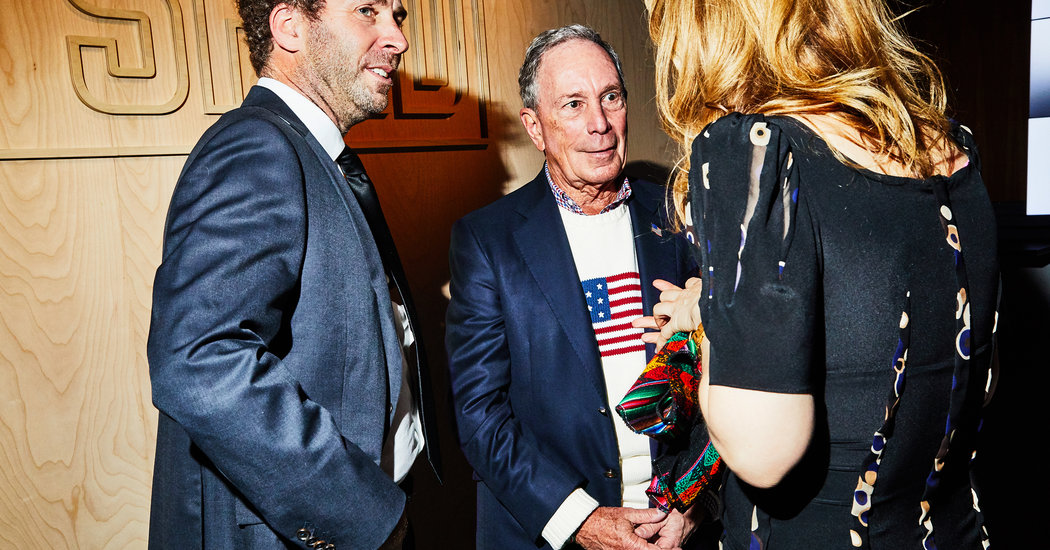
Michael R. Bloomberg may have forgotten that he’s not running for president.
Wearing a Ralph Lauren stars-and-stripes sweater under a blazer with a flag pin, the former mayor was pumping hands with everyone at the Shed, the new arts center at Hudson Yards that his administration was instrumental in creating.
Mr. Bloomberg helped guide the city’s $75 million contribution, and his personal foundation gave another $75 million (garnering him naming rights for the main Bloomberg Building).
He was joined by fellow billionaires Kenneth C. Griffin (whose $238 million pied-à-terre on Central Park South is America’s most expensive home), who gave $25 million, and Stephen M. Ross, the chairman of the Related Companies, which developed Hudson Yards.
At times, the founders dinner on Sunday, which kicked off a week of opening festivities, resembled a campaign rally.
“Mike had built a world-leading company, became one of the leading philanthropists of any era and become a model political leader,” said Daniel L. Doctoroff, Mr. Bloomberg’s former deputy mayor, who is chairman of the Shed’s board. “It took the Rockefeller family three generations to do what Mike has done in his lifetime.”
Among those dining on poached cod were Alex Poots, the chief executive and artistic director of the Shed; David Rockwell, Charles Renfro and Ricardo Scofidio, some of the architects who designed the center; and art-world cognoscenti, including Adam Weinberg, Glen Lowry, Thelma Golden and Colby Mugrabi.
They were joined by numerous artists including Steve McQueen, Steve Reich, Joan Jonas, Lawrence Weiner and Lynn Hersman Leeson, whose works the Shed has commissioned.
After dinner, Ben Whishaw, the actor, and Renée Fleming, the soprano, previewed “Norma Jeane Baker of Troy,” their coming collaboration with the writer Anne Carson. Next, Chen Shi-Zheng, the theater director, introduced a scene from “Dragon Spring, Phoenix Rise,” his new dance work.
“This is a wonderful thing for the city, it’s a wonderful thing for the arts, it’s a wonderful thing for America and the world,” Mr. Bloomberg said, between greeting fans.
And is there anything he is especially looking forward to seeing? “Poots is the right guy to ask about that,” he said, as he went back to shaking hands.
Rock of Ages
The Metropolitan Museum of Art celebrated performance of a more popular kind on Monday night, with the opening of the exhibit “Play It Loud: Instruments of Rock & Roll.”
The pop instruments include: the 1957 Gibson electric guitar that Chuck Berry used to record “Johnny B. Goode”; a Beatles drum set from 1963; an acrylic piano used by Lady Gaga during her Artpop tour; and fragments of Stratocaster guitars smashed onstage by Jimi Hendrix in 1967 and Kurt Cobain in 1993.
Baby boomers flooded the opening like it was 5 o’clock at Denny’s, strutting their finest vintage looks in line with the “rock ’n’ roll attire” dress code. There were tie-dyed T-shirts under fringed buckskin coats, Carnaby Street prints paired with plastic jewelry, and countless variations on Sgt. Pepper jackets, all worn with unapologetic panache.
“The only reason they wanted me here is that I’m old enough to be in a museum myself,” said Don Felder, who contributed the double-neck guitar he used to play the Eagles hit “Hotel California” for some 40 years.
He and Steve Miller, whose band is known for a string of velvety ’70s singles like “Take the Money and Run,” joined the Roots during a two-hour set in the great hall. Also wandering the ancient Greek galleries were Jimmy Page, Kate Pierson and Rosanne Cash, the musicians; Jeff Koons, the artist; Max Hollein, the museum’s director; and Anna Sui, the designer.
“I used to come here all the time, as an art history student, to sketch these vases and the marbles,” said Tina Weymouth, the bassist of Talking Heads, who has three guitars in the show.
And did it make her feel old to have her own artifacts join the collection?
“I don’t know about old,” she said, “but venerable.”







